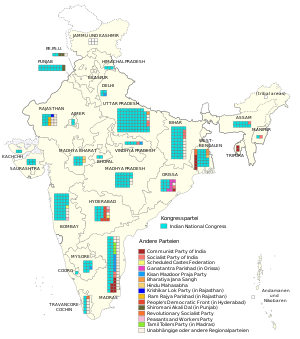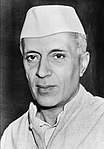1951–52 Indian general election
| ||||||||||||||||||||||
All 489 seats in the Lok Sabha 245 seats were needed for a majority | ||||||||||||||||||||||
|---|---|---|---|---|---|---|---|---|---|---|---|---|---|---|---|---|---|---|---|---|---|---|
| ||||||||||||||||||||||
 | ||||||||||||||||||||||
| ||||||||||||||||||||||
The Indian general election of 1951–52, held from 25 October 1951 to 21 February 1952, was the first election to the Lok Sabha since India became independent in August 1947.[1][2][3] It was conducted under the provisions of the Indian Constitution, which was adopted on 26 November 1949. Elections to most of the state legislatures took place simultaneously.
After the adoption of the constitution on 26 November 1949, the Constituent Assembly continued to act as the interim parliament. The interim cabinet was headed by Jawaharlal Nehru and consisted of 15 members from diverse communities and parties. Various members of this cabinet resigned from their posts and formed their own parties to contest the elections.
1949 candidates competed for 489 seats in the Lok Sabha. More than 173 million people out of an overall population of about 360 million were eligible to vote,[4] making it the largest election conducted at the time. Voter turnout was 45.7%.[5]
The Indian National Congress (INC) won a landslide victory, winning 364 of the 489 seats and 45% of the total votes polled. This was over four times as many votes as the second-largest party. Jawaharlal Nehru became the first democratically elected Prime Minister of the country.
India has a parliamentary system of government, where the Cabinet, headed by a Prime Minister, forms the de facto executive. Unlike most countries, the elections are conducted by an independent constitutional body, the Election Commission of India. Sukumar Sen was the first election commissioner of India.
India had 173,200,000 voters (excluding Jammu and Kashmir) in 1951 general elections.[6] All Indian citizens over the age of 21 were eligible to vote. Around 85% of the population could not read or write. This widespread illiteracy posed a challenge to the commission in organising the election. This was overcome by allotting each candidate a differently-coloured ballot box at the polling booth, on which each candidates name and symbol were written. 16,500 clerks were appointed on a contract of 6 months to type and collate the electorate rolls and 380,000 reams of paper were used for printing the rolls.[7]
Due to the harsh climate and challenging logistics, the election was held in 68 phases.[8] A total of 196,084 polling booths were set up, of which 27,527 booths were reserved for women. All states except Himachal Pradesh and Jammu & Kashmir voted in February–March 1952; no polls were held for Lok Sabha seats in Kashmir until 1967. Himachal Pradesh voted in 1951 for the first Lok Sabha weather tends to be inclement in February and March, heavy snow impending free movement.[9] The first votes of the election were cast in the tehsil (district) of Chini in Himachal Pradesh.[10]
Voters elected 489 members to the lower house of the Parliament of India. These were allotted across 401 constituencies in 25 Indian states. There were 314 constituencies electing one member using first-past-the-post system. 86 constituencies elected two members, one from general category and one from Scheduled Castes or Scheduled Tribes. There was one constituency with three elected representatives.[11] These multi-seat constituencies were present to fulfill the reservations granted to backward sections of the society by the Constitution. They were later abolished in the 1960s.
The Constitution also provides for 2 Anglo-Indian members to be nominated by the President of India.
Political parties
A total of 53 parties and 533 independents contested for the 489 seats in the election.[12] Two former cabinet colleagues of Nehru established separate political parties to challenge the INC's supremacy. While Shyama Prasad Mookerjee went on to found the Jana Sangh in October 1951, first Law Minister Dr. B. R. Ambedkar revived the Scheduled Castes Federation (which was later named the Republican Party).
Other parties which started coming to the forefront included the Kisan Mazdoor Praja Parishad, whose prime mover was Acharya Kripalani; the Socialist Party, which had Ram Manohar Lohia and Jayaprakash Narayan's leadership to boast of; and the Communist Party of India. However, these smaller parties were unable to make an electoral stand against the Indian National Congress.
Results
Government formation
The speaker of the first Lok Sabha was Ganesh Vasudev Mavalankar. The first Lok Sabha also witnessed 677 sittings (3,784 hours), the highest recorded count of the number of sitting hours. The Lok Sabha lasted its full term from 17 April 1952 until 4 April 1957.
Notable losses
First Law Minister B. R. Ambedkar was defeated in the Bombay (North Central) (reserved seat) constituency as Scheduled Castes Federation candidate by his little-known former assistant and Congress Candidate Narayan Sadoba Kajrolkar, who polled 1,38,137 votes compared to Ambedkar's 1,23,576 votes.[10]: 156 Dr Ambedkar then entered the parliament as a Rajya Sabha member. He contested by-poll from Bhandara in 1954 to try to enter Lok Sabha but again lost to Mr Borkar of Congress.
Acharya Kripalani lost from Faizabad in UP as KMPP candidate, but his wife Sucheta Kripalani defeated the Congress candidate Manmohini Sahgal in Delhi.[13]
See also
References
- ^
"Lok Sabha Results 1951-52". Election Commission of India.
{{cite web}}: CS1 maint: url-status (link) - ^
"Statistical Report on Lok Sabha Elections 1951-52" (PDF). Election Commission of India.
{{cite web}}: CS1 maint: url-status (link) - ^
"Lok Sabha Elections Stats Summary 1951-52" (PDF). Election Commission of India.
{{cite web}}: CS1 maint: url-status (link) - ^ India has nearly 83 crore voters: Brahma
- ^ Dieter Nohlen, Florian Grotz & Christof Hartmann (2001) Elections in Asia: A data handbook, Volume I, p. 572 ISBN 0-19-924958-X
- ^ "Great Indian Elections 1951-2019: The Story of How 90 Crore Voters Make and Break History".
- ^ Pareek, Shabdita (25 January 2016). "This Is How The First General Elections Were Held In Independent India". ScoopWhoop. Retrieved 21 December 2018.
- ^ "Interesting Facts About India's First General Elections". indiatimes.com. 28 April 2014. Retrieved 21 December 2018.
- ^ India's first voter in Himachal Pradesh, by Gautam Dhmeer, in the Deccan Herald; published 30 October 2012; retrieved 7 April 2014
- ^ a b Ramachandra Guha (2008). India After Gandhi: The History of the World's Largest Democracy. ISBN 978-0-06-095858-9.
- ^ "General Election of India 1951, List of Successful Candidate" (PDF). Election Commission of India. p. 6. Archived from the original (PDF) on 8 October 2014. Retrieved 12 January 2010.
- ^ "First general elections in India: All you need to know". India Today. 10 February 2016. Retrieved 21 December 2018.
- ^ David Gilmartin (2014). "Chapter 5: The paradox of patronage and the people's sovereignty". In Anastasia Pivliavsky (ed.). Patronage as Politics in South Asia. Cambridge University of Press. pp. 151–152. ISBN 978-1-107-05608-4.
Further reading
- Guha, Ramachandra. "Democracy's Biggest Gamble," World Policy Journal, (Spring 2002) 19#1 pp. 95–103


